*This post may contain affiliate links. Read more »
Bánh Bao Chay, or as we call them at my house, “mom’s buns” are a really big deal in Vietnamese street food culture. These buns were originally crafted to offer a filling and satisfying meal on the go. But for real, the only place I want to go is back to the dang steamer to grab, like three more.


Enter your email & I'll send it to your inbox. Plus, get great new recipes from me every week!
By submitting this form, you consent to receive emails from Cinnamon Snail.
Like banh tran trong, and mi xao xi dau, the best thing about these Vietnamese clouds full of veggies is that they make a killer meal on their own. In your hands is a recipe that not only puts the authentic essence of the buns within reach in your home kitchen, but also serves as your ticket to achieving perfection on your first attempt!
Roll up your sleeves, put on your cutest apron, and let’s make Bánh Bao Chay together that will blow your freaking mind.
Jump to:
🥰Why you'll adore this banh bao recipe
✊Vegan AF: The whole point of Bánh Bao Chay is that they are veggie buns, but here I have made them extra toothsome with ground bits of my tender homemade seitan!
👨🍳I have made a billion buns! My wife and I were nominated to represent the USA in the World Street Food Congress in the Philippines. For 15 hours a day, for a week we made thousands and thousands of bao for a never-ending sea of customers in Manila. I also teach the art of steamed buns in my vegan dim sum classes.
✅Tested and Approved Worldwide: Like all of the vegan recipes, I share this one’s been seriously tested-the-heck-out-of by over 500 recipe testers from all around the world!


🙌 Learn to make restaurant-quality Vietnamese food
This guide to my most popular vegan Vietnamese recipes is 100% FREE, & you'll love the actual heck out of it 🥰
🧅 Ingredients in this vegan banh bao recipe
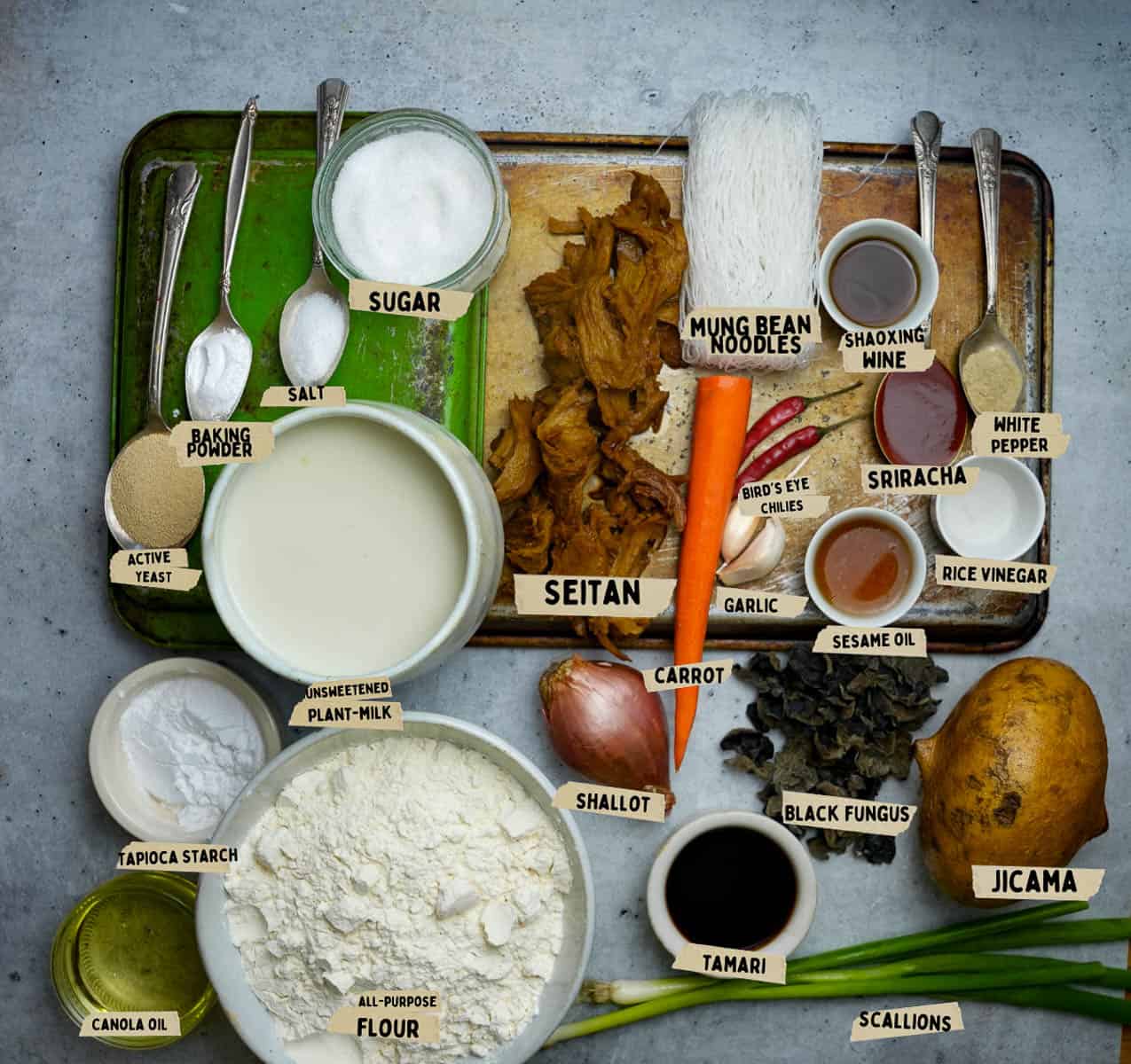
Seitan
Known as “gà tanh” in Vietnam, this protein-packed ingredient takes center stage in vegan cuisine. I use it to make everything from vegan butter chicken, to Middle Eastern Kofta. Here, it replaces the mouthfeel of ground pork or Chinese sausage that are sometimes in Vietnamese bao. You can also make the recipe using store-bought vegan mince, or rehydrated TVP in place of the seitan.
Jicama (Củ Sắn)
This crunchy root vegetable brings a refreshing contrast to the recipe. This is one of the only recipes I make where I cook jiciama, because otherwise, it is great raw dipped in some tahini sauce, or spicy fermented shatta. If jicama isn’t available, you can use chopped water chestnuts for a similar crunch.
Black Fungus (Nấm Ôn Đới)
These gnarly-looking fungi bring an earthy, umami-rich note to the buns. If black fungus is nowhere to be found, wood ear mushrooms are very similar. Otherwise, use shredded fresh shiitake or oyster mushrooms.
Bird's Eye Chilies (Ớt Hiểm)
AKA Thai chilies, these tiny, fiery chilies pack a punch of heat, adding a hint of excitement to your buns. If you don’t like spice, you can leave them out entirely, and the buns will still be epic.
Shaoxing Wine
Straight from China, this rice wine imparts a subtle complexity to the filling. I use it in this recipe to create an all-out umami powerhouse.
Mung Bean Vermicelli (Bún Tàu)
These translucent noodles hail from Vietnam and are made from mung bean starch. Not only are they gluten-free, but they also provide a delicate, chewy texture to the buns. If you can’t find mung bean vermicelli, rice vermicelli is a great alternative (and also make pretty amazing bihun goreng). Either way, rehydrate them by soaking them in warm water until tender. There is no need to boil them.

*See the recipe card at the bottom of the page for exact quantities, nutritional info, and detailed cooking directions.
🤯Variations
Korean BBQ bánh bao
Instead of the filling in this recipe, make a batch of my vegan bulgogi, and either mince it by hand, or pulse it in a food processor a few times to use as bun filling. Serve the Korean BBQ buns with a side of kimchi, some Korean BBQ sauce, and spicy Korean cucumber salad.
Filipino Sisig bánh bao chay
Roughly chop some of my crispy tofu sisig and use it as a bun filling! Serve with some calamansi lemonade and a side of ensaladang talong. You will naturally be required by law to make tupig for dessert.
📖How to make bánh bao chay
Make these bad boys perfectly on your first shot by following these step-by-step instructions with important tips. Or you can follow along with the easy-to-print recipe card towards the bottom of this page.
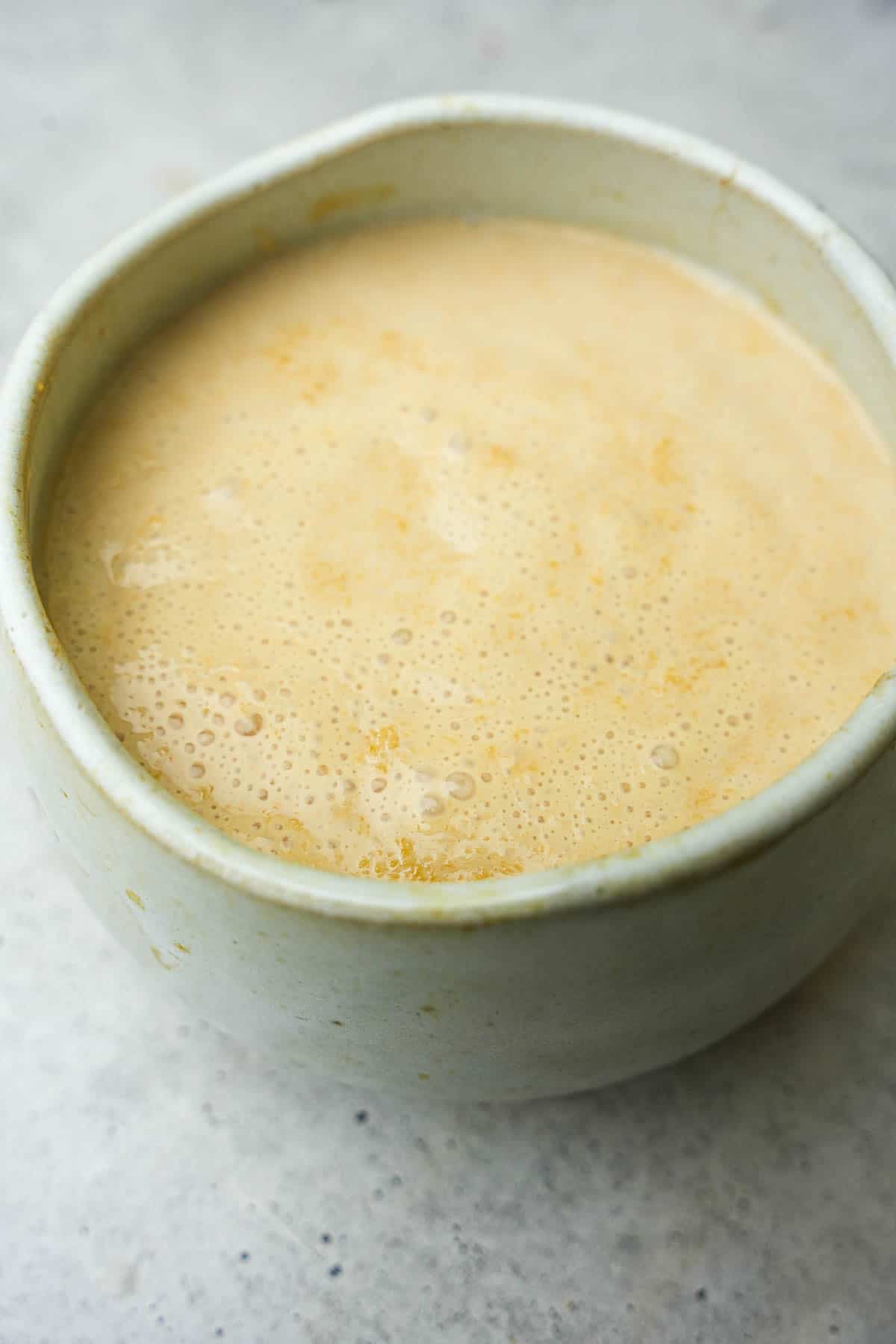
Step One
Heat the plant-based milk until just warm to the touch (not exceeding 110°F/ 43°C), then mix in the active dry yeast. Allow the yeast to proof for 5-6 minutes until frothy.

Step Two
Combine sugar, tapioca starch, salt, baking powder, and all-purpose flour in a large bowl, and add the frothy yeast mixture and canola oil to dry ingredients.

Step Three
Knead into a smooth, elastic dough, and let the dough rise in a lightly oiled bowl, covered, in a warm place for an hour until it doubles in size.

Step Four
While the dough is resting, make the filling.
Heat sesame oil in a pan over medium heat and sauté the shallots, garlic, and ground seitan for 3 minutes.

Step Five
Add scallions, bird’s eye chilies, jicama, and carrots. Stir fry for 4 more minutes.
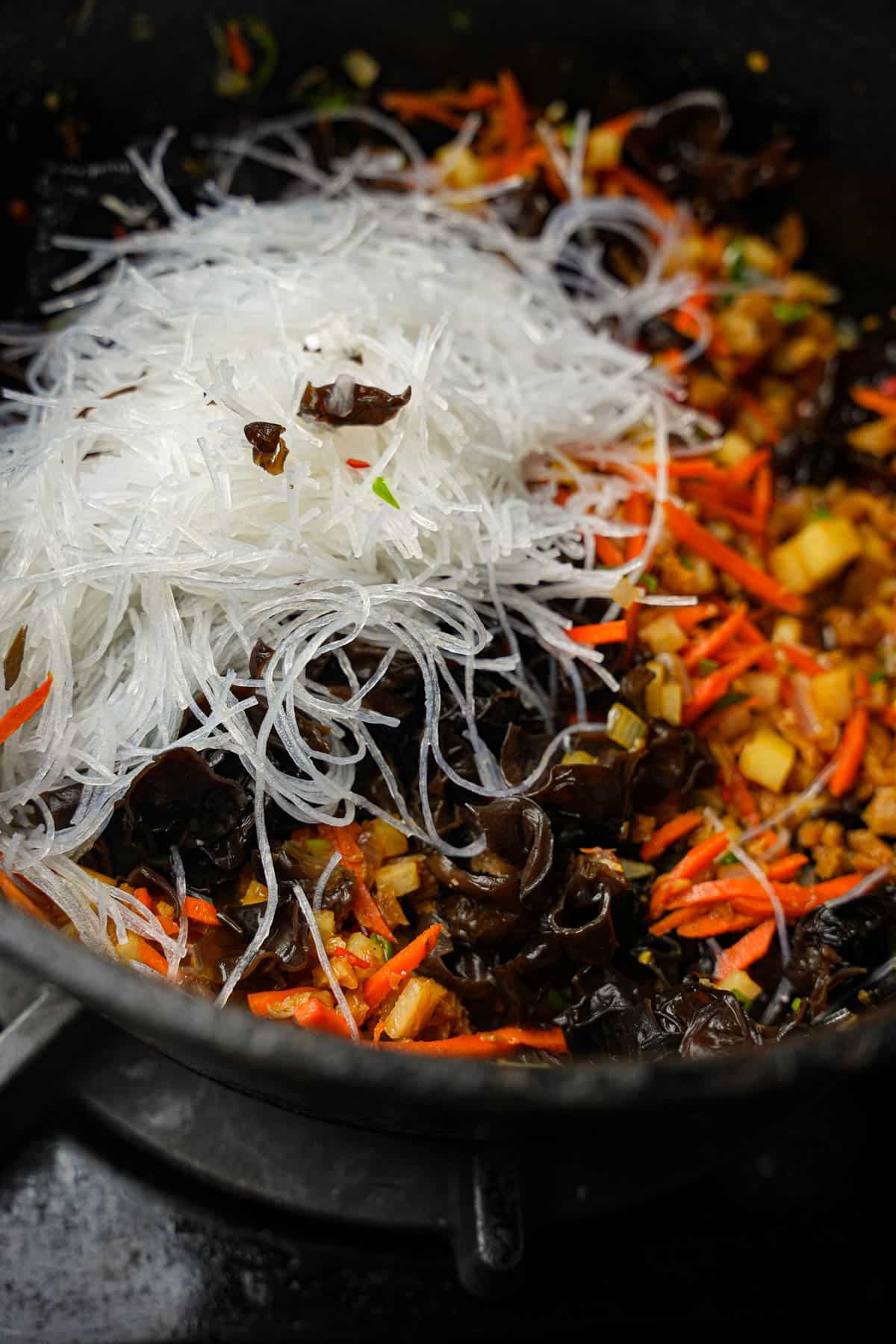
Step Six
Mix in tamari, sriracha, rice vinegar, white pepper, shaoxing wine, chopped rehydrated fungus, and chopped drained mung bean vermicelli. Cook for a few minutes until most liquid is absorbed. Set aside to cool.
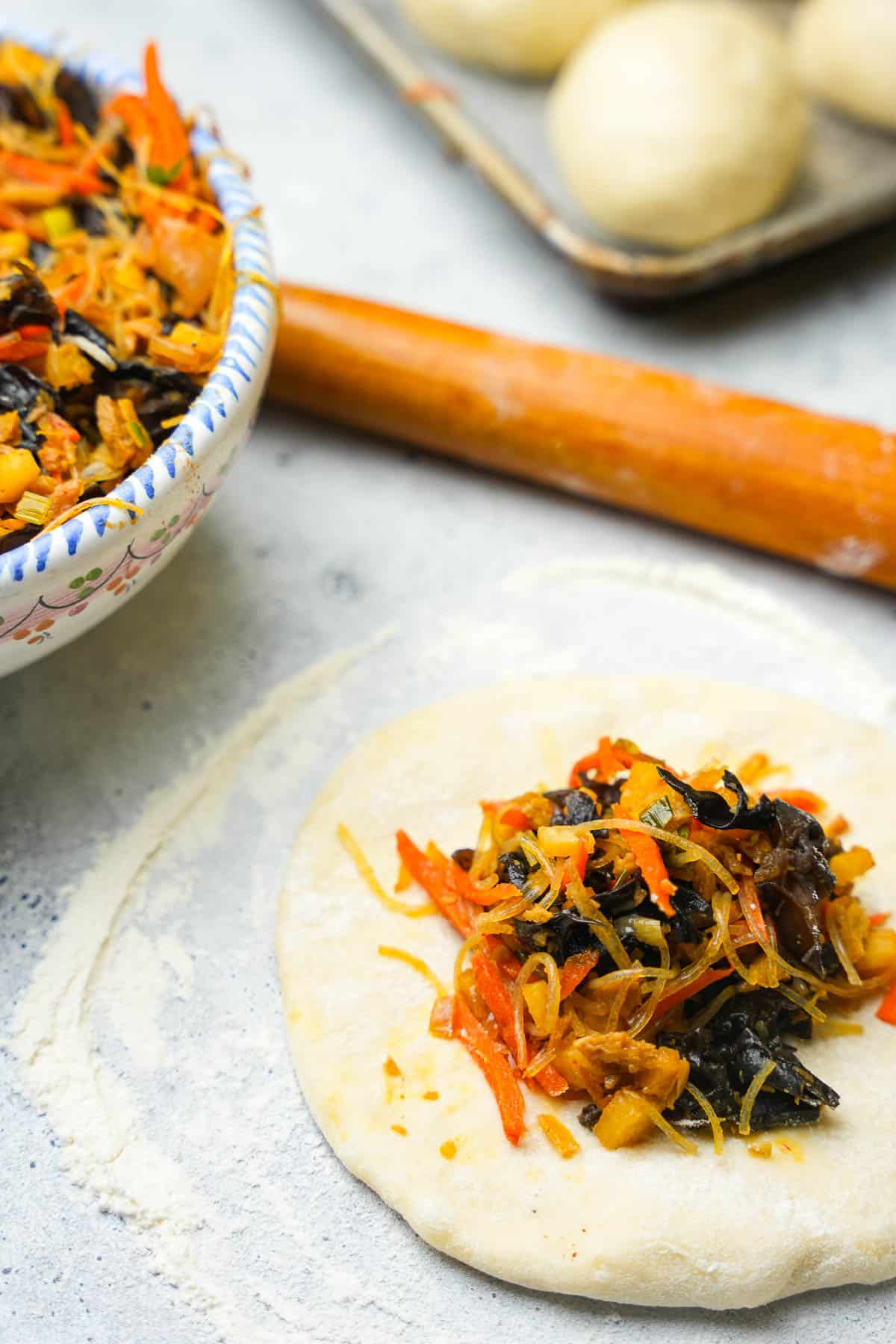
Step Seven
Punch down and divide the dough into 12 portions, roll each into a ball, and flatten into 5-inch (13 cm.) circles. Place a big spoonful of filling in the center of each dough circle.
Seal the edges, creating pleats at the top to encase the filling securely. Repeat until all buns are filled.
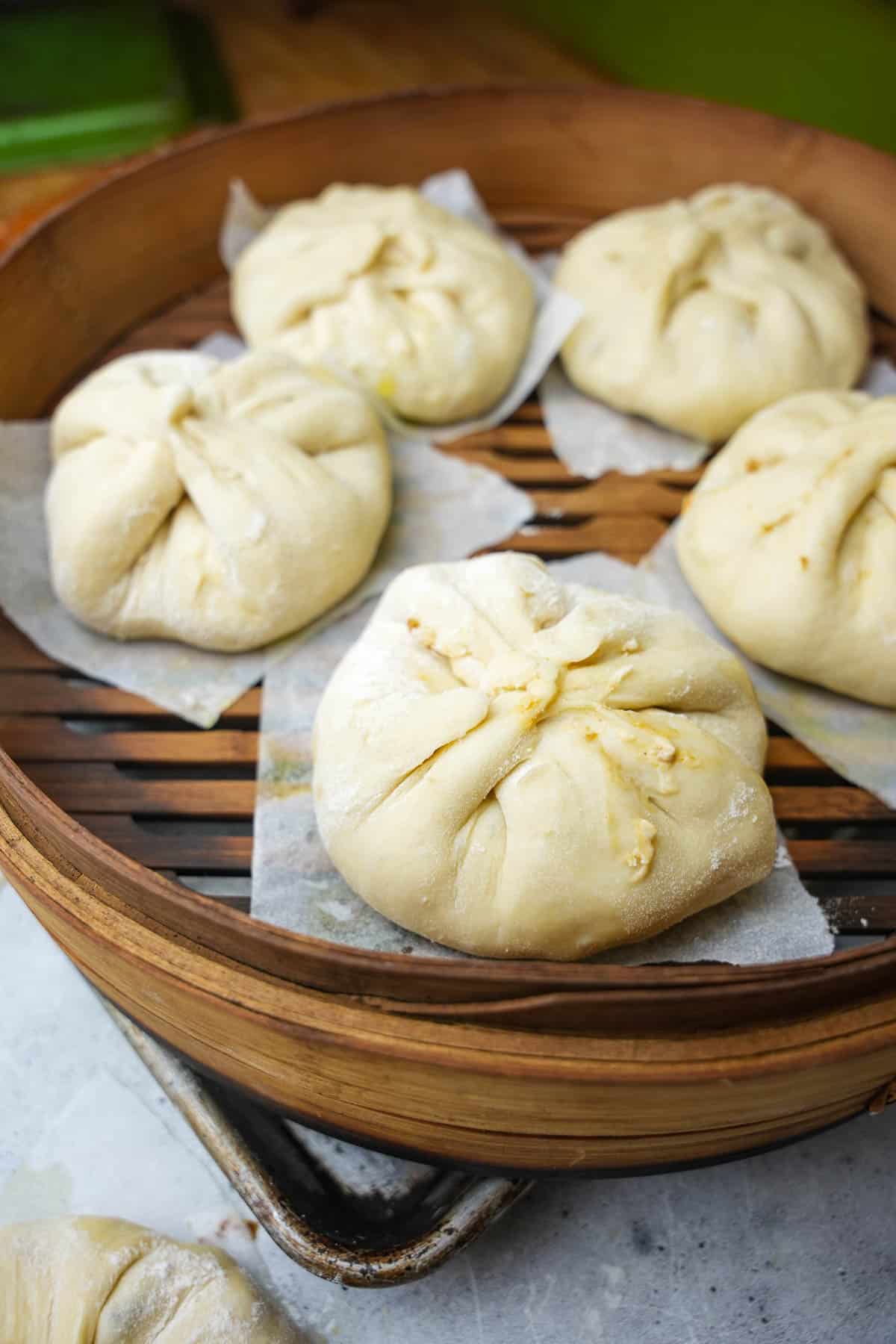
Step Eight
Preheat a steamer with water and a splash of vinegar to prevent yellowing.
Brush parchment paper squares with oil, and place each bun on a square.
Arrange buns on steamer trays and steam for 15-20 minutes until fluffy and fully cooked.
Eat yer' buns with a giant plate of veggies like urap sayur.
💡Serving Ideas
Serve these steamed buns alongside classics like Bami Goreng (stir-fried thick noodles), or a big giant bowl of mee rebus.
Serve em with Tahu Goreng over your favorite rice (mine are nasi minyak, nasi uduk and nasi kunyit). They are great to have with a hearty bowl of Sayur Lodeh – a rich coconut milk-based vegetable stew – served with banana leaf-wrapped Lontong.
🤔Wha? No dessert?
Dive into Vietnamese Bánh Flan, Chè Khoai Mon, or Chè Bà Mau. Indonesian and Malay sweets like Ondeh Ondeh, Martabak, and Kuih Ketayap are all sweet food classics that go great with steamed buns.

👉Top tips
- Dough Consistency: When kneading the dough, aim for a smooth and slightly elastic texture. Adjust the flour or plant-based milk as needed to achieve the right consistency – a dough that’s too sticky or too dry can affect the final result. Make sure your hands are lightly floured, which will make it easier to form the buns.
- Steaming Setup: If you aren’t using a bamboo steamer, line the lid with a clean cloth to prevent condensation from dripping onto the buns. Steam them over medium heat, and ensure they don’t become dense.
- Pleating Technique: When forming the buns, don’t be afraid to practice your pleating technique. The more pleats you create at the top, the better the seal, and the more appealing the final appearance of the buns.
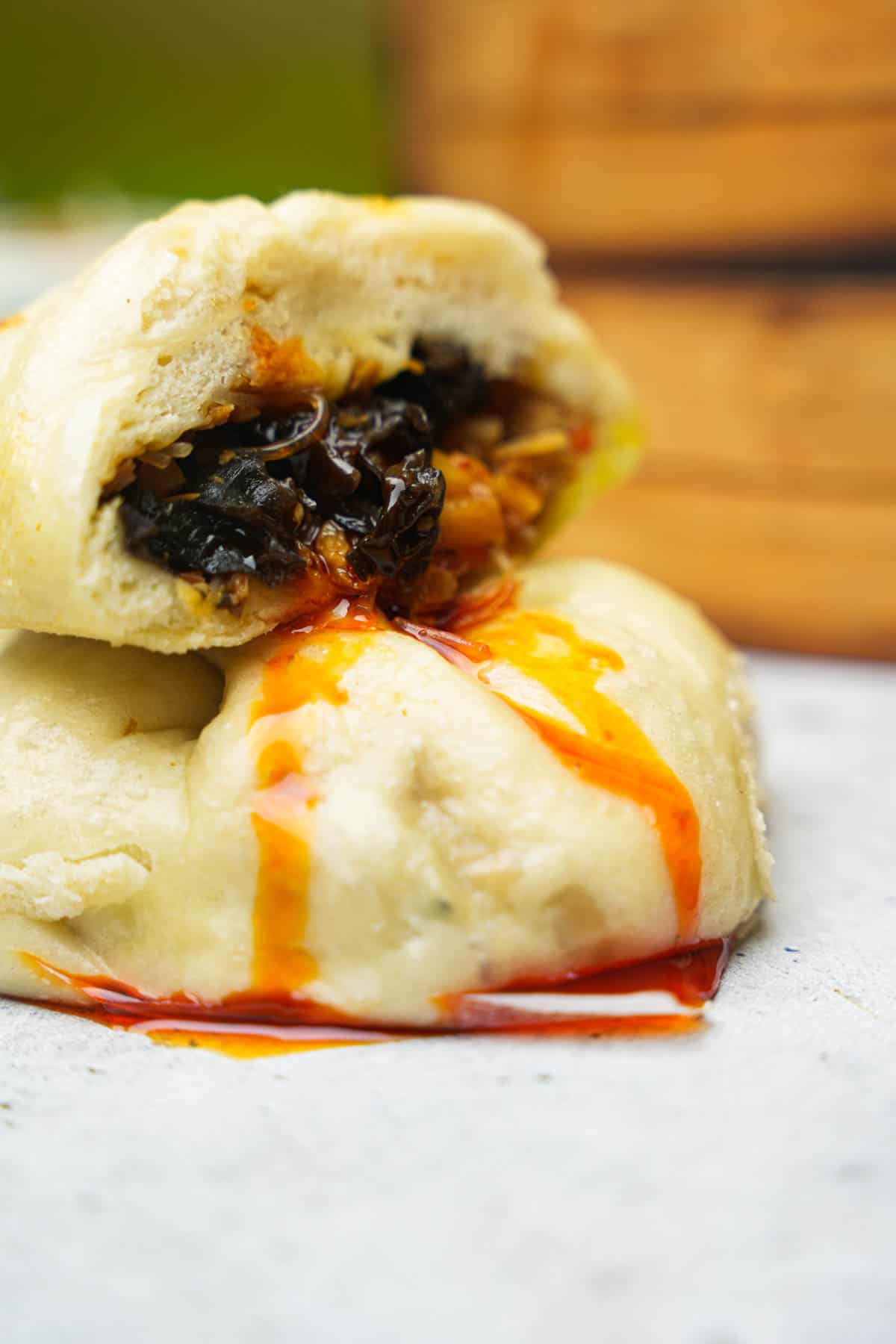
🤷♀️FAQ
Yes, you can prepare the dough ahead and refrigerate it overnight. Just make sure to let it come to room temperature before shaping and steaming so that the yeast becomes active.
Absolutely, these buns freeze really well. Once steamed and cooled, freeze them on a tray. Once they feel solidly frozen, transfer them in a freezer-safe bag or container and keep them on hand for an easy snack.
While a bamboo steamer is traditional, you can also use other types of steamers. Just ensure the buns have enough space to expand without touching each other during steaming. Stretching a cloth between the top of the steamer and the lid can prevent droplets of water from falling onto the steaming buns, which messes up their cooking.
Certainly, feel free to experiment with different vegetables like bell peppers, steamed and sliced kabocha, or chopped Chinese broccoli.
Adding vinegar to the steaming water helps prevent the buns from turning yellow during steaming, ensuring they maintain an appealing appearance.
Storing: Store your buns in an airtight container or resealable plastic bag after steaming and cooling them. Keep them at room temperature for up to 3-4 days.
Reheating: When you’re ready to enjoy the buns, reheat them gently to preserve their soft texture. Steam the buns in a steamer or microwave them with a damp paper towel to prevent them from drying out. Steaming for a few minutes or cutting them in half and microwaving for about 20-30 seconds on low power should do the trick.
Flavor Preservation: Reheating with care helps maintain the original flavor and moisture of the buns. Avoid overcooking, as excessive heat can cause the buns to become overly soft and potentially sticky.
🥟 Here's what to serve with banh bao chay:

Perfect bánh bao chay (Vegan Steamed Buns)
Equipment
Ingredients
Dough
- 1 ½ cups unsweetened plant-based milk
- 2 ½ teaspoons active dry yeast
- ⅓ cup sugar
- ⅓ cup tapioca starch
- ½ teaspoon salt
- 1 teaspoon baking powder
- 3 ¾ cups all-purpose flour plus extra for rolling and forming the buns
- ⅓ cup canola oil
Bun filling
- 2 tablespoons sesame oil
- 1 shallot finely diced
- 2 cloves garlic minced
- 1 cup ground seitan or vegan mince
- 2 scallions thinly sliced
- 1-2 bird’s eye chilies minced (optional)
- 1 cup jicama finely diced
- 1 cup carrot julienne cut, or shredded
- 3 tablespoons tamari or soy sauce of your preference
- 1 ½ teaspoons sriracha
- 1 teaspoon rice vinegar
- ½ teaspoon white pepper
- 4 teaspoons shaoxing wine
- ⅔ cup black fungus or wood ear mushrooms rehydrated and roughly chopped
- 1.4 oz dried mung bean vermicelli rehydrated and roughly chopped
For Steaming:
- Parchment paper
- Canola oil
- 1 teaspoon white vinegar
Instructions
Dough
- Warm the plant-based milk slightly (should be just warm to the touch, not hotter than 110 degrees), then sprinkle the active dry yeast over it. Let it sit for a few minutes until it becomes frothy.
- In a large bowl, combine sugar, tapioca starch, salt, baking powder, and all-purpose flour.
- Add the frothy yeast mixture and canola oil to the dry ingredients.
- Mix until the dough forms. Knead it for a few minutes until it's smooth and elastic.
- Place the dough in a lightly oiled bowl. Cover it with a damp cloth or plate and let it rise in a warm place for one hour until it doubles in size.
Bun FIlling
- Heat sesame oil in a pan over medium heat. After 90 seconds when the oil is hot, stir in diced shallot, garlic and ground seitan (or vegan mince). Sauté for 3 minutes until fragrant.
- Add thinly sliced scallions, bird’s eye chilies, diced jicama, and julienne-cut carrots. Stir fry for 4 more minutes until the scallions are wilted.
- Stir in tamari (or soy sauce), sriracha, rice vinegar, white pepper, shaoxing wine, wood ear mushrooms, and mung bean vermicelli. Stir fry until most of the liquid has absorbed. Set the filling aside to cool.
Forming the buns
- Punch down the risen dough and divide it into 12 equal portions.
- Roll each portion into a ball. Flatten each ball into a 5-inch (13 cm.) circle using extra flour for rolling if needed.
- Place a spoonful of the prepared filling in the center of each dough circle.
- Gather the edges of the dough circle and pinch them together to seal, creating a pleated appearance at the top. Using slightly moistened hands will make it easier to get a reliable seal. No filling should be visible from the outside.
Steaming the buns
- Preheat a large steamer over medium heat with 3 cups of water in the bottom. Add vinegar to the water to prevent the buns from yellowing at all as they steam.
- Cut parchment paper into squares and brush them lightly with canola oil, or any neutral-tasting cooking oil you prefer.
- Place each bun on a prepared parchment square.
- Arrange the buns onto a steamer tray (or multiple trays, depending on the size of your steamer). Steam the buns for about 17-22 minutes until they're fluffy and fully cooked.
Notes

Enter your email & I'll send it to your inbox. Plus, get great new recipes from me every week!
By submitting this form, you consent to receive emails from Cinnamon Snail.

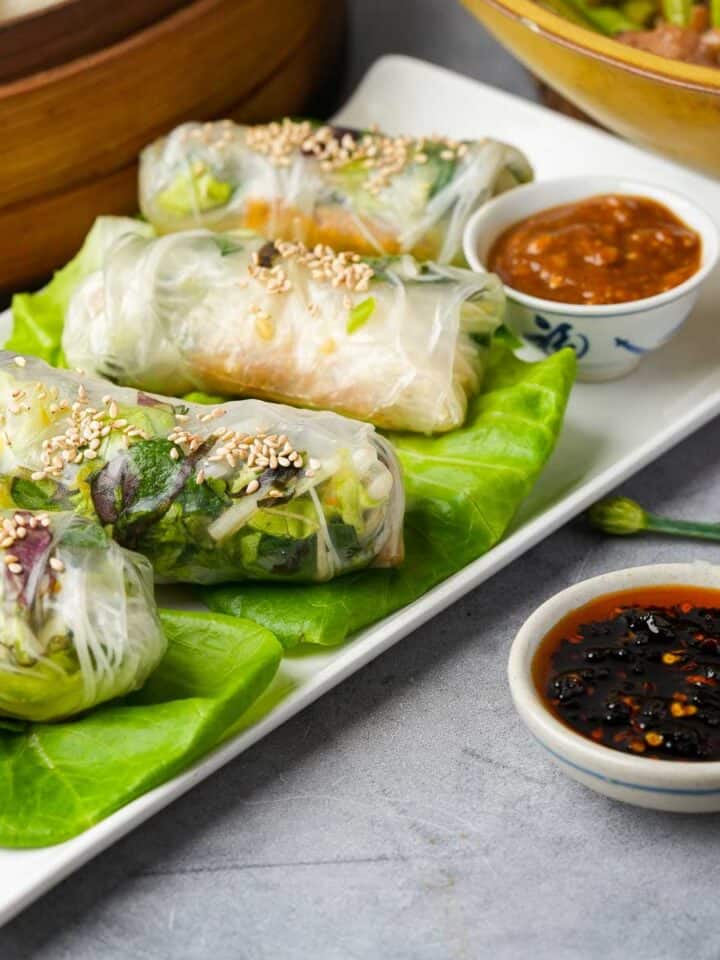
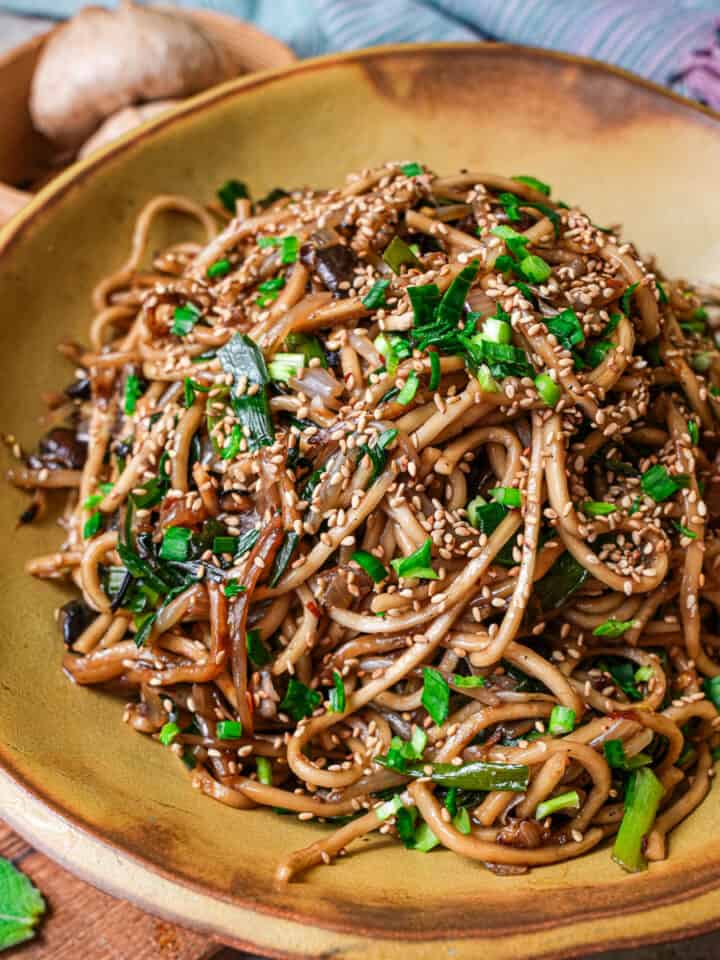
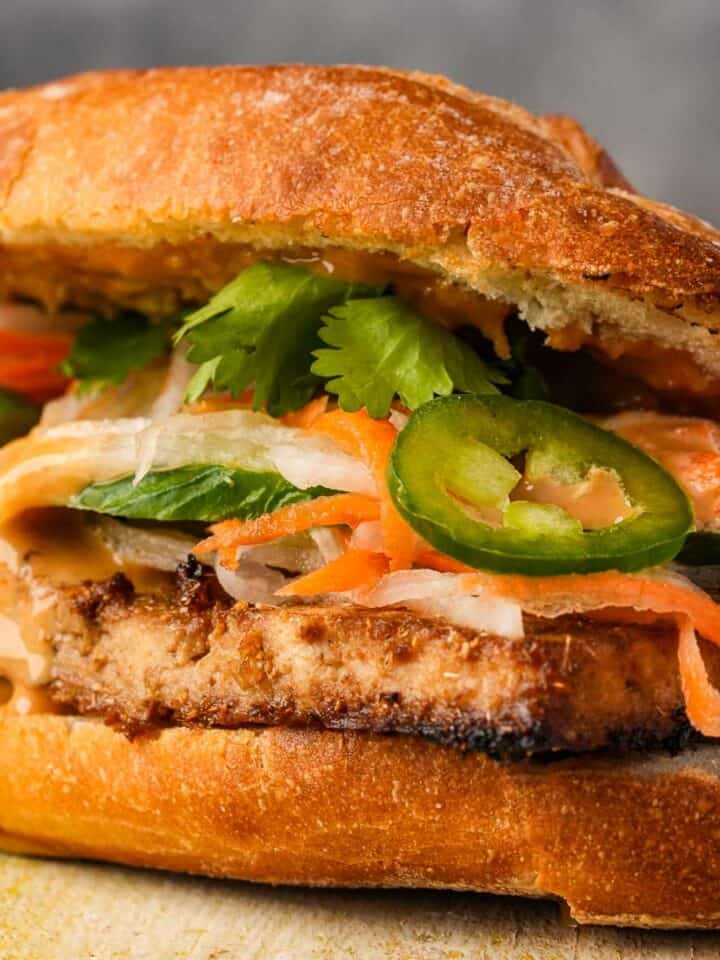





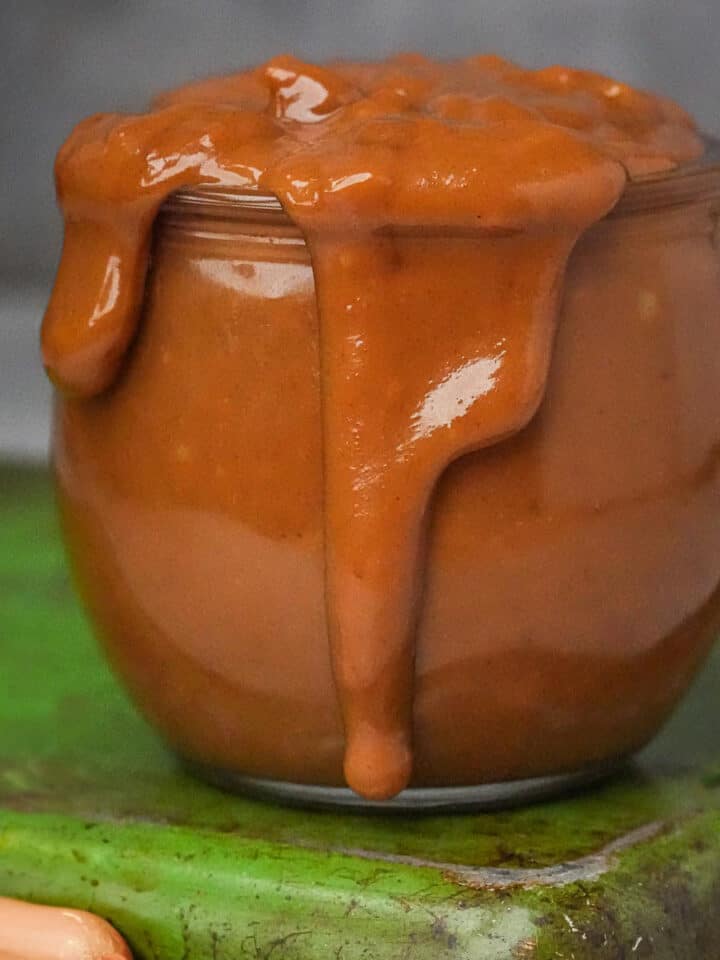
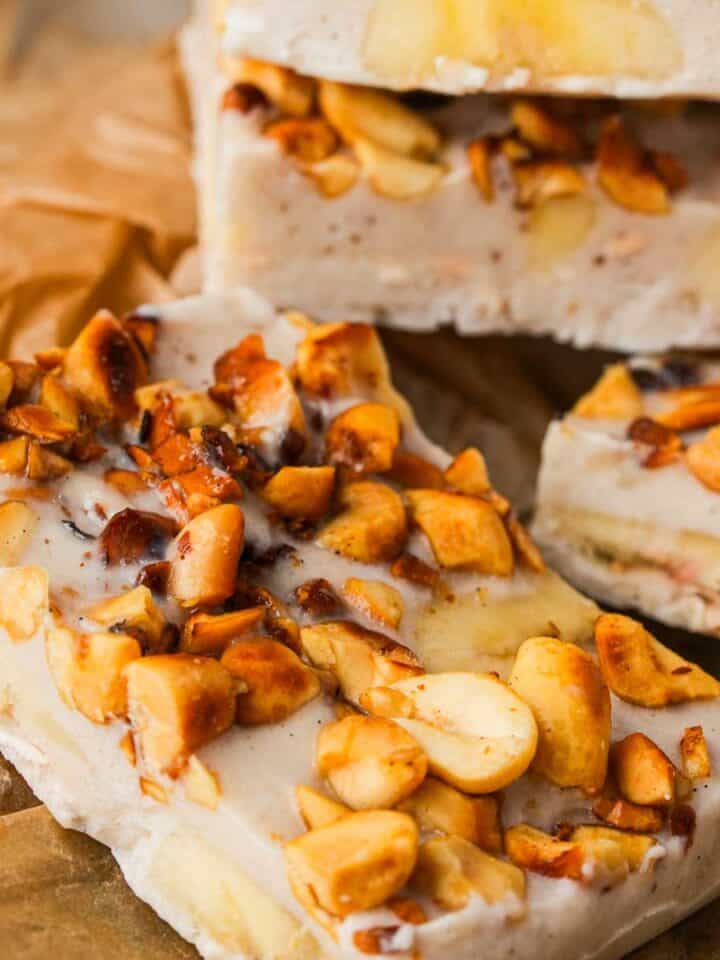
Meg Rohan says
Yep. These are great and way easier than I imagined. Tasty! I had made a peanut chilli condiment that went with it really well. Kid friendly! Thank you Adam.
Adam Sobel says
Yay! you made these after all! So glad you loved 'em, Meg.